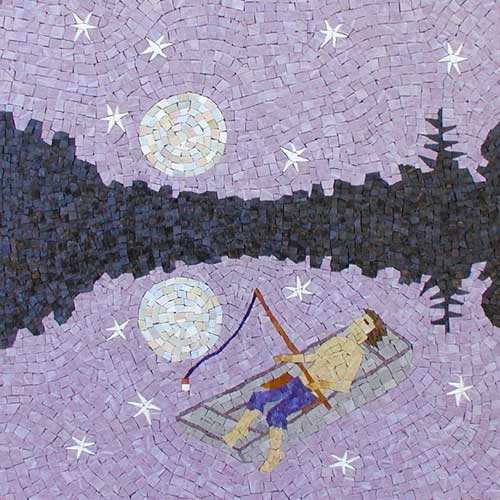
“Listening to Bullfrogs” mosaic art. smalti on panel. 24 in x 24 in
“Listening to Bullfrogs” Mosaic ArtThis mosaic is about the night sky and how the trees and and other objects on the horizon make inky black silhouettes against the sky. The sky itself isn’t dark, but has the faint glow of a million stars that are each too faint to be seen individually. In this respect, I think this mosaic is one of the most “photo-realistic” pieces of art I have ever made. As far as the color of the sky and the trees around the lake, it is exactly like the image burned into my mind from years ago. The other less “realistic” aspects of the mosaic do not lessen this effect. This is the truest visual representation I think I could make of floating on an oxbow lake at night and listening to bullfrogs. I think this mosaic suggests why the invention of photography in the 1800’s didn’t kill painting and other visual art forms as was predicted at the time. Even though the composition of the above mosaic is very simple, it manages to have extremely “natural” and extremely cartoonish elements integrated fairly seamlessly. I think what makes most visual art engaging is the mixture of the “photo-realistic” and the symbolic or conspicuously artificial. I have two engineering degrees but no formal training in art, so I am somewhat perplexed by discussions about creativity and “left-brain” versus “right-brain” activities. I think most of what people assume about creativity and the process of making a piece of visual art doesn’t have much basis in fact. Particularly, I am doubtful about the unquestioned assumption that creativity is most allied with the “right-brain” or visual part of the mind as opposed to the symbolic part of the mind. I am also doubtful about the popular belief that people are either creative or analytical, and these are more or less opposite personality traits. I know from my own experience as an artist that the visual part of the mind can be as analytical as the symbolic/language-oriented part of the mind. Dream is the essence of creativity, and the form of our dreams tells us much about the nature of creativity. Like many engineers and scientists, I have dreamt the solutions to technical problems, even mathematical problems, after wrestling unsuccessfully with the issue for days. Most oddly, these dreams of technical insight had the same emotional intensity and strange magical elements of other dreams. For another example, consider the Renaissance artists. Their defining characteristic is that they were analytical and used things like dissection, applied geometry and other sciences to inform their art. In fact, this analytical approach is what distinguished them as a group (not just Da Vinci) from the previous artists of the medieval period. This analytical approach made their art more naturalistic and less symbolic in the elemental sense. I believe Chagall may be the most important artist of all time for the simple reason that no other artist I have seen approaches his ability to dance between the symbolic and the visual. I look at his canvases and see an artist for whom imagination was more important than information. I see shear poetry leaping into forms. I see a creative impulse harnessing both sides of the mind, like a team of horses. His canvases sing. |

